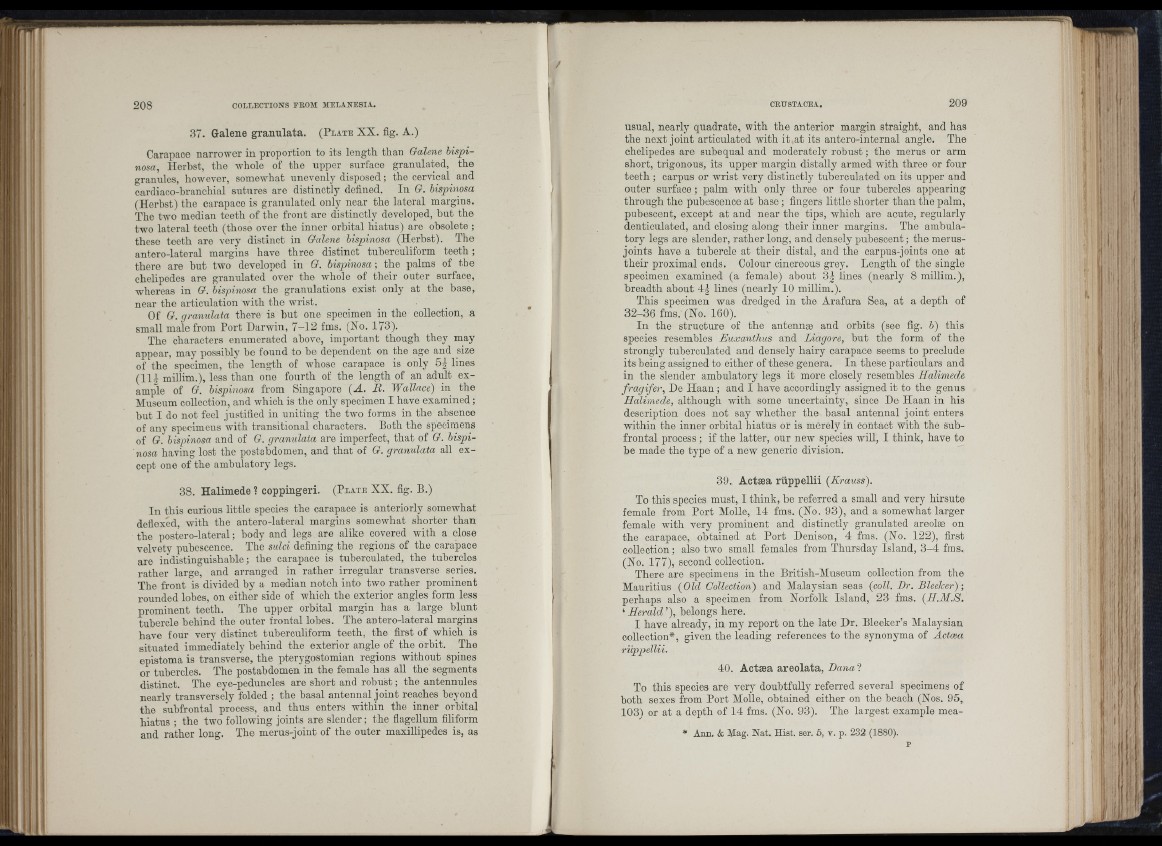
i i
il ]
ii r
I I ..
208 COLLECTIONS FEOM MELANESIA.
37. Galene granulata. ( P l a t e XX. fig. A.)
Carapace narrower in proportion to its length than Galene bispi-
nosa, Herhst, the whole of the upper surface granulated, the
granules, however, somewhat unevenly disposed; the cervical and
cardiaco-hranchial sutures are distinctly defined. In G. bispinosa
(Herhst) the carapace is granulated only near the lateral margins.
The two median teeth of the front are distinctly developed, but the
two lateral teeth (those over the inner orbital hiatus) are obsolete;
these teeth are very distinct in Galene bispinosa (Herhst). The
antero-lateral margins have three distinct tuberculiform te e th ;
there are but two developed in G. bispinosa ; the palms of the
chelipedes are granulated over the whole of their outer surface,
whereas in G. bispinosa the granulations exist only at the base,
near the articulation with the wrist.
Of G. granulata there is hut one specimen in the collection, a
small male from Port Darwin, 7 -12 fms. (No. 173).
The characters enumerated above, important though they may
appear, may possibly be found to he dependent on the age and size
of the wspecimen, the length of whose carapace is only 5 | lines
( H i millim.), less than one fourth of the length of an adult example
of G. bispinosa from Singapore (A . R . Wallace) in the
Aluseum collection, and which is the only specimen I have examined;
but I do not feel justified in uniting the two forms in the absence
of any specimens with transitional characters. Both the specimens
of G. bispinosa and of G. granulata are imperfect, th a t of G. bispinosa
having lost the postabdomen, and th at of G. granulata all except
one of the ambulatory legs.
38. Halimede ? coppingeri. ( P l a t e XX. fig. B.)
In this curious little species the carapace is anteriorly somewhat
deflexed, with the antero-lateral margins somewhat shorter than
the postero-lateral; body and legs are alike covered with a close
velvety pubescence. The sulci defining the regions of the carapace
are indistinguishable; the carapace is tuberculated, the tubercles
rather large, and arranged in rather irregular transverse series.
The front is divided by a median notch into two rather prominent
rounded lobes, on either side of which the exterior angles form less
prominent teeth. The upper orbital margin has a large blunt
tubercle behind the outer frontal lobes. The antero-lateral margins
have four very distinct tuberculiform teeth, the first of which is
situated immediately behind the exterior angle of the orbit. The
epistoma is transverse, the pterygostomian regions without spines
or tubercles. The postabdomen in the female has all the segments
distinct. The eye-pednncles are short and ro b u st; the antennules
nearly transversely folded ; the basal antennal joint reaches beyond
the subfrontal process, and thus enters within the inner orbital
hiatus ; the two following joints are slender; the flagellum filiform
and rather long. The merus-joint of the outer maxillipedes is, as
CEUSTACEA, 209
usual, nearly quadrate, with the anterior margin straight, and has
the next joint articulated with it at its antero-internal angle. The
chelipedes are subequal and moderately robust ; tho merus or arm
short, trigonous, its upper margin distally armed with three or four
teeth ; carpus or wrist very distinctly tuberculated on its upper and
outer surface ; palm with only three or four tubercles appearing
through the pubescence at base ; fingers little shorter than the palm,
pubescent, except at and near the tips, which are acute, regularly
denticulated, and closiug along their inner margins. The ambulatory
legs are slender, rather long, and densely pubescent ; the merus-
joints have a tubercle at their distal, and the carpus-joints one at
their proximal ends. Colour cinereous grey. Length of the single
specimen examined (a female) about 31 lines (nearly 8 millim.),
breadth about 4 | lines (nearly 10 millim.).
This specimen was dredged in the Arafura Sea, at a depth of
32-36 fms. (No. 160).
In the structure of the antennæ and orbits (see fig. b) this
species resembles Euxanthus and Liagore, but the form of the
strongly tuberculated and densely hairy carapace seems to preclude
its being assigned to either of these genera. In these particulars and
in the slender ambulatory legs it more closely resembles Halimede
fragifer, De Haan ; and I have accordingly assigned it to the genus
Halimede, although with some uncertainty, since De Haan in his
description does not say whether the basal antennal joint enters
within the inner orbital hiatus or is merely in contact with the sub-
frontal process ; if the latter, our new species will, I think, have to
he made the type of a new generic division.
39. Actæa rüppellii (Krauss).
To this species must, 1 think, be referred a small aud very hirsute
female from Port Alolle, 14 fms. (No. 93), and a somewhat larger
female with very prominent and distinctly granulated areolæ on
the carapace, obtained at Port Denison, 4 fms. (No. 122), first
collection ; also two small females from Thursday Island, 3 -4 fms.
(No. 177), second collection.
There are specimens in the British-Aluseum collection from the
Mauritius (Old Collection) and Malaysian seas (coll. Dr. Bleeker);
perhaps also a specimen from Norfolk Island, 23 fms. (H.M.S.
‘ Herald ’), belongs here.
I have already, in my report on the late Dr. Bleeker’s Alalaysian
collection*, given the leading references to the synonyma of Actæa
rüppellii.
40. Actæa areolata, Dana ?
To this species are very doubtfully referred several specimens of
both sexes from Port Alolle, obtained either on the beach (Nos. 95,
103) or at a depth of 14 fms. (No. 93). The largest example mea-
* Ann. & Mag. Nat. Hist. ser. 5, v. p. 232 (1880).
i' t o
!
i l l
* Î' « f
É: :: ;U|i '
I" '
:|i
: i ;
ii (
te M
I Iti